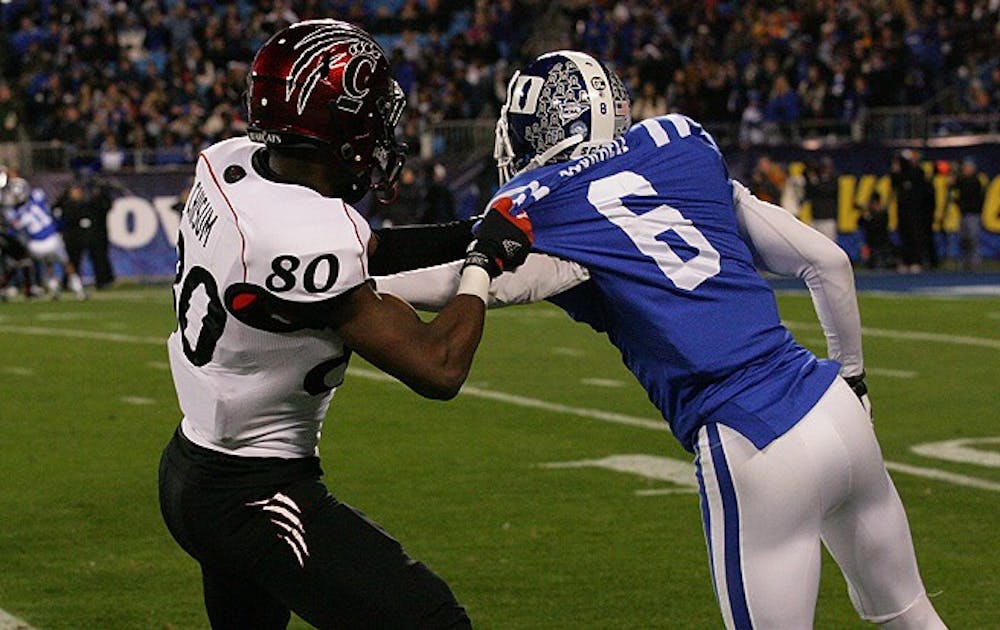After graduating four of its top defensive backs, the Duke secondary could be one of the team’s biggest question marks heading into the 2013 season.
The Blue Devils gave up more than 260 yards through the air to opponents last year and will have several holes to fill in a secondary that struggled to defend the vertical pass.
“It certainly was a nemesis to us,” Duke head coach David Cutcliffe said. “We’ve addressed [getting beat by the deep ball] all off season, schematically…. But you’ve got to keep it in front of you better than we did a year ago.”
While most college programs use defensive packages with four defensive backs on the field at a time, the Blue Devils primarily run a five-defensive back 4-2-5 scheme, with three safeties and two cornerbacks.
The loss of senior safeties Walt Canty and Jordon Byas and cornerbacks Lee Butler and Tony Foster has left little experience in the secondary.
The rebuilding process will center on redshirt senior Ross Cockrell, one of the few remaining members of the secondary with significant game experience. The 2012 All-ACC selection spent most of last season on an island against the conference’s best receivers, as the Blue Devils were often forced to put eight men in the box to defend the run. Cockrell is Duke’s best single-coverage option and will have to be reliable again in 2013 if the secondary has any chance of limiting opponents’ passing attacks.
To go along with the experience of Cockrell at cornerback will be safeties Jeremy Cash—who practiced with the team last season while sitting out the year after transferring—and Dwayne Norman. Cash transfered after playing in five games as a true freshman at Ohio State. At 6-foot-2 and 210 pounds, Cash owns an imposing physical frame and will have a large role to fill next season. Norman played in all 13 games last season as a true freshman and finished the year ranked second among All-ACC freshmen with 60 tackles.
Redshirt freshman Corbin McCarthy is listed as the third starter at safety on the spring depth chart. McCarthy only played in two games last year, recording four tackles before a shoulder injury knocked him out for the season.
“Ross Cockrell is where everything starts,” Cutcliffe said. “Right now, if we can stay healthy our starting three safeties are Dwayne Norman, Jeremy Cash and Corbin McCarthy. I really like the looks of that…. We can be more athletic than we have been in the secondary.”
But even if the Blue Devils are more athletic in the secondary than they were last year, the lack of experience could be troubling as the season approaches.
The fifth and final starting spot in the secondary, the second cornerback position, is the spot most up in the air at this point. The current depth spring depth chart has redshirt freshman DeVon Edwards filling that role. Edwards has yet to play in his first Division I football game.
“We’re going to need a lot of contributors on defense because everybody we lost last year, it goes without saying, were seniors and leaders on the team,” Cockrell said. “We need guys to come and step in for the guys we lost. Not just new players but new leaders.”
After the starting five defensive backs, the secondary has almost zero game experience. Incoming freshmen Quay Mann and Evrett Edwards will both see playing time in their first season as Blue Devils. Coaches are high on the young prospects, but it is yet to be seen how quickly they can adjust to the speed of the college game. Fifth-year senior Garrett Patterson will also see significant playing time for the first time in his career. The backup safeties also have little experience between them.
During spring practice, which culminates Saturday with the Spring Game, Duke has been focusing on defending against its “nemesis,” the vertical pass. Limiting big plays through the air will be key if the Blue Devils want to challenge the ACC’s best and make a run at a conference championship.
“We can’t give up explosive plays, and that’s where we struggled most as a defense,” Cockrell said. “Especially at critical times in the game, when it was a third down, and we really needed to get a stop or a critical drive and we needed to get a stop, we gave up a touchdown. Something just seemed to happen. We have some tweaks for our defense to try and limit those and protect ourselves deep to short.”
Get The Chronicle straight to your inbox
Signup for our weekly newsletter. Cancel at any time.

